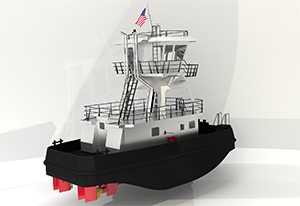It’s a little 850-hp pushboat with a big job. It’s also the first tug its shipyard has ever built.
Capt Cooper, under construction since December 2015 at Metal Trades Inc., soon will serve North Carolina’s Bald Head Island as a vital link for supplies residents need in their daily lives. The existing boat’s crew is eager for the safer and more reliable replacement they will use to navigate the 4 nm across the Cape Fear River.
The operator, Bald Head Island Limited LLC, runs a single-barge operation delivering trucks, fuel, restaurant supplies and construction materials to a landing on the island, which has 1,000 year-round residents and up to 5,000 people during the summer. On the return trip to Southport, on North Carolina’s mainland, the 100-by-34-foot deck barge carries the island’s garbage away.
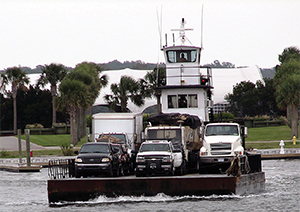 |
|
Existing tug Capt Alex pushes a load of vehicles toward the landing at North Carolina’s Bald Head Island. |
|
Courtesy Bald Head Island Limited LLC |
The vessels make four round-trips a day and do nothing else. Therefore, the tugboat does not need a head, galley or living quarters for the two-person crew. Nor does it need to store lube oil or spare parts.
“Capt Cooper is being built to do one thing and that is to push the barge back and forth to this island on the four-mile run,” said Capt. Claude McKernan, manager of Bald Head Island Limited. “We looked at making her simple to maintain and reliable — and safe, of course.”
In one important respect, the repetitive run is not at all simple. Upon arrival at the island’s entrance channel, the tow often encounters perpendicularly a strong, long-shore current exceeding 4 knots while it slips through jetties under full power. When the barge’s bow is between the jetties, the captain must maintain course while the current is still affecting the tug. Once inside the entrance, a hard turn to starboard is required to line up for the landing. The difficult approach requires very precise steering and handling characteristics.
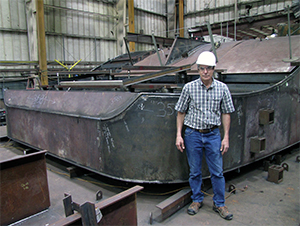 |
|
John Geiges, project manager at Metal Trades LLC, with the inverted Capt Cooper hull inside the yard’s fabrication shop in April. |
The existing tug, Capt Alex, was not purpose-built for the challenging maneuver, and the 40-year-old vessel is plagued by frequent mechanical breakdowns. Any service disruptions mean the island is cut off from essential supplies. Truck cargoes halt, food stocks dwindle and construction slows.
Aside from improving reliability, the operators felt they needed a more stable platform, so Capt Cooper was designed with greater width — 24 feet versus the 18-foot-wide Capt Alex.
“The new boat is much beamier,” McKernan said. “It has more beam to give it more stability. When you put the rudder hard over, (Capt. Alex) leans over quite a bit when she goes into the turn. It’s unsettling.”
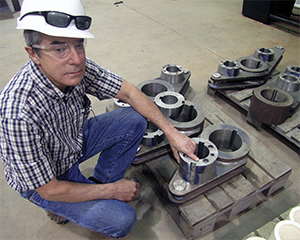 |
|
Geiges explains Capt Cooper’s customized configuration for its tiller attachments. |
But there was a catch. Because of the close-quarters maneuvering necessary to line the barge up with the island’s hydraulic ramp, the entire vessel could not be wider than the old boat. To solve that, Corning Townsend at CT Marine drew up what is now affectionately known as “The Wedge” shape — wide at the bow but not as wide aft.
“There is a very narrow entrance,” McKernan said. “It’s quite a challenge. You clear the jetties and then you have a 200-foot stretch of narrow channel, then you make a hard turn to starboard, and your port quarter gets real close to the bulkhead, so we need to maintain the narrow beam back aft but not up front. Up front, it can be as wide as the barge.”
CT also contributed a steering solution, with flanking rudders that focus extra thrust to achieve the precise turning.
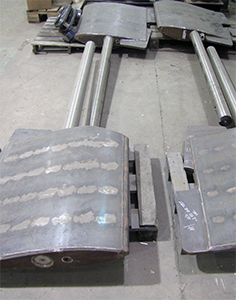 |
|
The boat’s flanking rudders. |
“Because of the physical constraints on the Bald Head Island side, the boat could be no longer than 50 feet, nor wider than 17 feet at the transom,” Townsend said. “Several tight maneuvers are required, often combating both wind and current. This led to the use of the CT Twin Differential Steering, which gives about 50 percent more side thrust than conventional steering.”
Capt Cooper has two main rudders and two flanking rudders on each side, for a total of eight rudders. McKernan said the flanking rudders “go a full 45 degrees hard-over instead of the 35 degrees that is typical.”
At the Metal Trades yard in April, project manager John Geiges still had the loose components to help him explain the geometry and synchronicity of the rudders. “For a vessel that needs high maneuverability, where a bow or stern thruster is not an option, the flanking rudder provides the ability to side-walk the boat,” Geiges said. “It has be able to walk the boat sideways to make that real tight turn.”
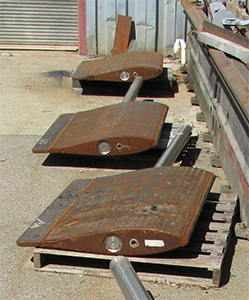 |
|
The main rudders on Capt Cooper. |
Not only is Bald Head Island’s starboard turn tight, the inlet’s waters are shallow and the operators can’t afford to get stuck in the mud. A unique aspect of Capt Cooper’s system is the attachment of the tillers to the rudder system. Normally all that gear is below deck, but not in this case. The tug draws just 5.5 feet.
“For a vessel with this shallow of a draft, there just wasn’t enough room,” Geiges said. “So we have an above-deck steering system, and it is protected from the elements for assembly, disassembly and maintenance. We needed an encapsulated taper-lock bushing system to attach the tillers to the rudder posts.”
The uniquely positioned steering system and extra side thrust were part of the calculation of what is necessary and safe for the challenging entrance to the harbor. So was the unique “Wedge” hull shape.
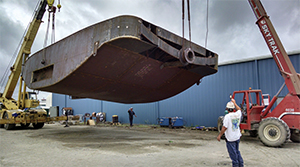 |
|
The hull that will eventually become Capt Cooper is turned right-side-up and transferred out of the fab shop by two cranes at Metal Trades in May. |
|
Courtesy Metal Trades Inc. |
“The increase in side force due to the rudders required a beam greater than 17 feet for adequate stability,” Townsend said. “So this boat was designed with a 17-foot-wide transom and a 24-foot-wide headlog. In addition, the hull is steel to take the wear and tear of workboat operation, but the lower house and raised pilothouse are made of aluminum, giving the towboat a greater safety margin for both static and dynamic transverse stability.”
McKernan said the company wanted an aluminum house for cheaper maintenance, as it would not need coating. Capt Alex’s “height of eye” provides good visibility, so the new boat was designed to match that, he said.
“The raised pilothouse, which has deck-to-ceiling windows and no forward console, dramatically increases the pilot’s visibility,” Townsend said. “It is raised 8 feet above the lower house on stiffened legs for superior sightlines when trailer trucks are on board the barge.”
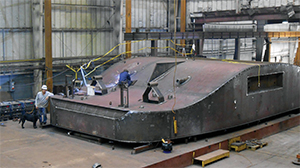 |
|
Back in April, the Capt Cooper hull was upside-down in the Metal Trades fab shop, while welders and other shipyard workers fitted the hull bottom plate. Production on the first-ever tugboat built at Metal Trades began in December 2015. |
Bald Head Island Limited went with a known quantity when it chose CT Marine, considering the Maine firm’s expertise in designing shallow-draft pushboats. But for construction of Capt Cooper, the operator selected a yard that had never built a tugboat before. Metal Trades, of Hollywood, S.C., proved its mettle in building highly engineered steel structures, for both marine and terrestrial applications.
McKernan’s organization considered Metal Trades because of its reputation in fabrication and welding and the fact that it is in the Carolinas, reducing transport costs and allowing the Bald Head Island staff to visit the boat inexpensively. Ultimately, McKernan said he was impressed with the yard’s know-how in making products including huge transformer casings for the power industry and its overall marine experience. Metal Trades produces specialized double-hull fuel barges and Improved Navy Lighterage System modules used in Military Sealift Command missions. It is a repair yard for Navy ships and refurbishes and repowers tugboats and other workboats.
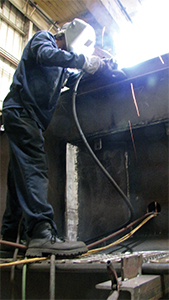 |
|
Metal Trades’ Mikey Staton welds a chine bar on the boat. The company’s reputation for welding expertise was a factor in winning the job to build its first tug. |
“There’s a lot of steel knowledge here,” Geiges said. “It’s accuracy and it’s weld quality. A crappy weld probably holds as well as a pretty one. But the pretty one is going to exclude moisture and it’s going to hold paint better.”
Townsend said, over his 40-year career, Capt Cooper is one of the tugs of which he is proudest. That’s based on listening keenly to the precise needs of the customer and designing exactly the right combination of power, steering and stability required within the strict parameters. It was like a puzzle.
“To me, it’s one of the important boats we’ve done,” Townsend said. “It was a challenge, and that’s what makes it fun.”

